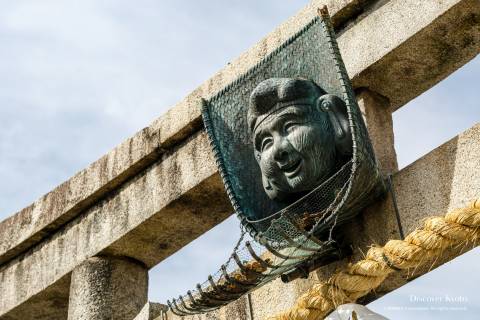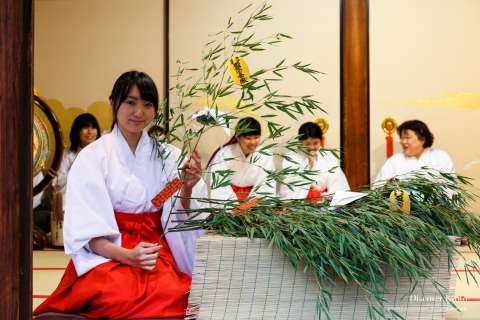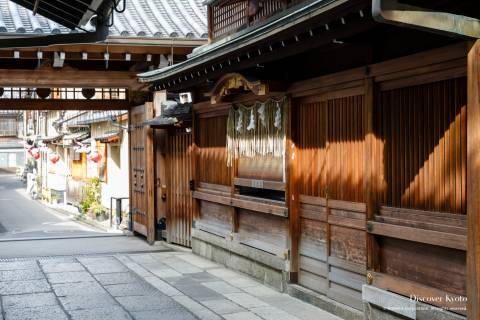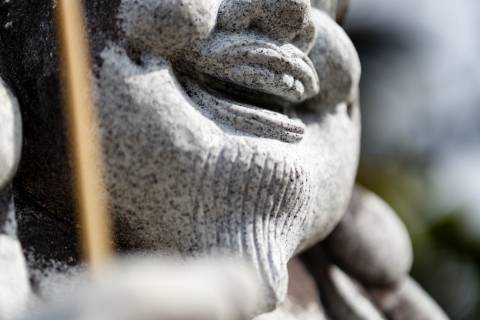Kyoto Ebisu Shrine|京都ゑびす神社
Overview

Called Ebissan by the locals, Kyoto Ebisu Shrine is known as one of the country’s three most popular shrines dedicated to Ebisu, one of the Seven Gods of Fortune. Considered the patron of fishermen and business people, Ebisu’s jolly figure with his telltale fishing pole can be found throughout the grounds. Located just south of the Zen temple Kennin-ji, this Ebisu Shrine is the place to be during the January Tōka Ebisu festival, when business owners from all over gather in the hopes that the shrine’s lucky bamboo will bring good fortune to their enterprises.
Ebisu Shrine is known as one of the three most important Ebisu shrines in the country.
Features
Seven Lucky Gods: Ebisu

One of the Shichifukujin (Seven Gods of Fortune), Ebisu is the patron god of business and fishermen. Signs of Ebisu worship can be found all over this shrine, including statues of the smiling fisherman on the shrine’s sandō entrance path and a depiction of his happy face mounted on the torii gate and in the kaguraden.
Lucky Coin Toss

On the center of the shrine’s second torii is a depiction of Ebisu’s face looking down cheerily at those who pass. Interestingly enough, there’s also a kumade (rake) beneath Ebisu’s depiction, one you might see has collected quite the collection of coins. It’s a local tradition to toss spare change up at the rake in the hopes of getting it in the basket there, the rake itself symbolizing “raking in fortune”. It is said that if you successfully toss a coin in your wish may come true. If you have some cash on hand, why not give it a try yourself?
Lucky Bamboo

Since the tradition of Ebisu’s lucky bamboo being used to attract good fortune to businesses originated at Kyoto Ebisu Shrine, their Tōka Ebisu Festival in January when the bamboo is available is exceedingly popular. People come from all over to purchase these fukuzasa, which are blessed by shrine maidens performing a kagura dance and handed out by geisha apprentices or actresses in traditional dress. Luck-seekers can purchase various charms to hang from their fukuzasa in the hopes of attracting even more fortune, and each charm carries its own lucky meaning in Japanese culture. The red sea bream often seen on Ebisu’s hook is eaten at celebrations, the shrine maiden’s bell calls luck to you, the storehouse “stores” luck for you, the traditional cash boxes indicate wealth… feel free to mix and match while creating your custom lucky bamboo at this famous Kyoto festival!
Knock, Knock, Knocking on Ebisu’s Door

Due to being considered something of an elder deity, Ebisu is thought to be hard of hearing. In order to make sure their prayers are properly heard, some constituents choose to go around to the left of the main sanctuary after praying in front. Once there, worshipers rap their knuckles on the wooden panel and then repeat the prayer again in the hopes that it will get Ebisu’s attention and increase the chances of their prayer being heard. However, please don’t bang on this board- knock politely, or you might make irritate Ebisu instead!
History
Eight hundred years ago, the Kyoto Ebisu Shrine was founded in 1202 to protect the soon-to-be constructed Zen temple of Kennin-ji. The founding abbot of Kennin-ji, Eisai, encountered rough weather on his journey back to Japan from studying in China, but it was said that when he paid respects to the lucky deity Ebisu aboard his ship the storm abated and he was able to return to his homeland safely. In thanks for being saved, he established the Ebisu Shrine upon his return.
Now independent from Kennin-ji, the Kyoto Ebisu Shrine can be found beside the Zen temple, and is known as one of the three most important Ebisu shrines in the country alongside Nishinomiya Shrine in Hyōgo and Imamiya Ebisu Shrine in Osaka.
Though many people associate the god Ebisu and all his shrines with the good luck bamboo displayed by business owners and companies hoping for shōbai hanjō (prosperous business) blessings, this tradition was actually born at Kyoto Ebisu Shrine, based off the shape of their original ofuda amulets.
Events
January 1st | New Year’s Ritual (Saitan-sai) |
|---|---|
January 8th – 12th | Tōka Ebisu Festival |
February | Setsubun |
3rd Sunday in May | Reitai-sai/Shinkō-sai |
June 30th | Summer Purification (Nagoshi no Ōharae-shiki) |
4th Sunday in September | Gratitude to Business Cards Ritual (Meishi Kansha-sai) |
October 19th – 20th | Hatsuka Ebisu Festival |
November 16th | Fire Ritual (Ohitaki-sai) |
December 31st | Winter Purification and New Year’s Bell Ringing (Ōharae-shiki, Joya no Kane) |
Access
Address
〒605-0811 京都府京都市東山区大和大路通四条下る四丁目小松町125
| TEL | 075-525-0005 |
| WEB | http://www.kyoto-ebisu.jp/ |
Admission
- General Admission: Free
Hours
- General Admission: 9:00 – 17:00
- Closed: Never
Gallery
-




 +16
+16
